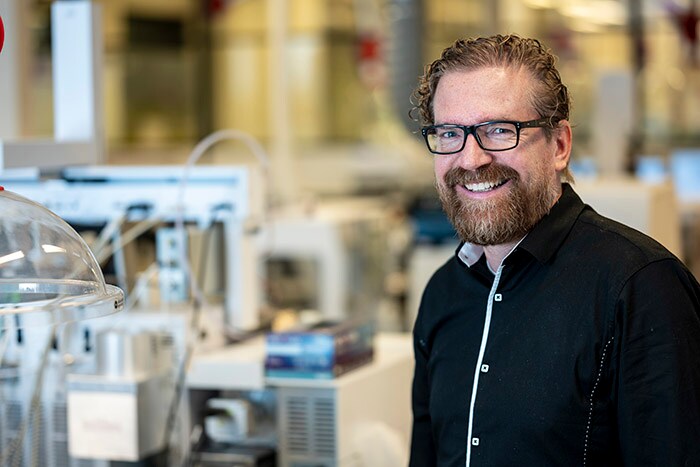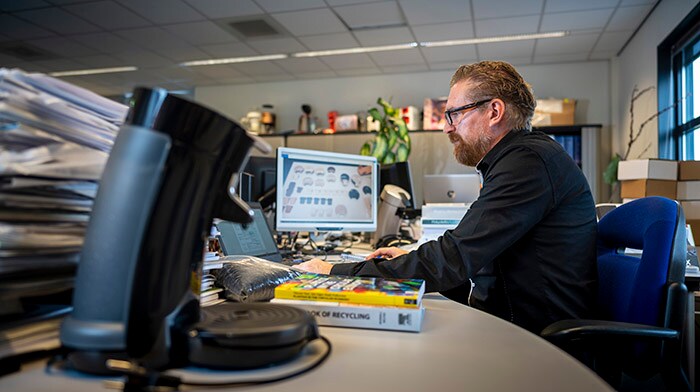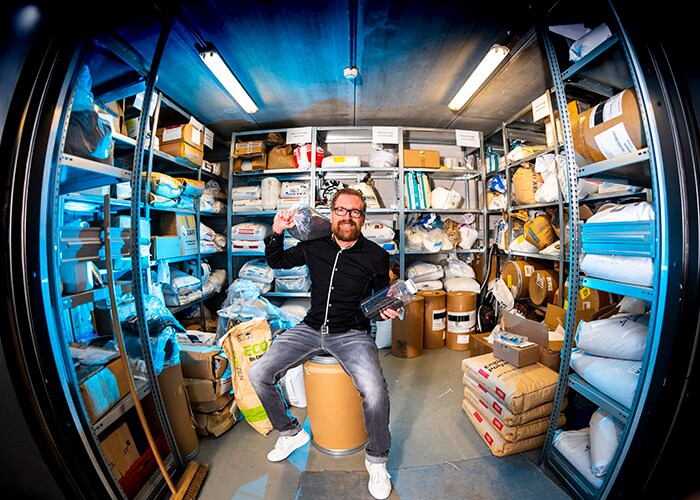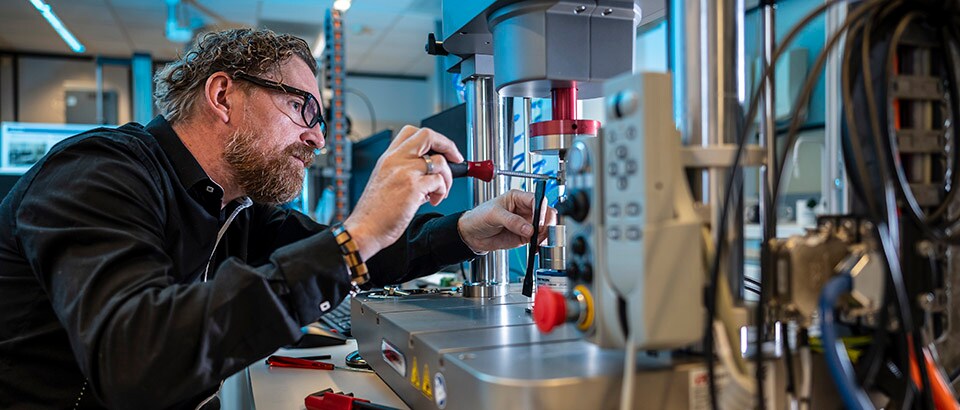“De eerste kilo gerecycled plastic, die gebruikten we in een stofzuiger. Dat was in 2009. Inmiddels zitten we in totaal al op meer dan 2 miljoen kilo per jaar, voor zowel medische apparatuur, persoonlijke gezondheidszorg en huishoudelijke apparaten.” De technische ontwikkelingen op het gebied van recycling gaan dus hard. Maar als het aan Mark-Olof Dirksen zou liggen, dan mag het nog wel wat harder gaan. Hij is specialist in het selecteren en ontwikkelen van materialen in een technische expertisegroep. Vanuit Drachten werkt deze groep samen met teams van over de hele wereld om Philips-producten nog duurzamer te maken. Nu bestaat 15 procent van de Philips-omzet nog uit circulaire producten en diensten, in 2025 moet dat zijn opgeschroefd naar 25 procent. Een ‘circulair product’ wil nog niet per se zeggen dat er gebruik wordt gemaakt van gerecyclede materialen, aldus Mark-Olof: “Circulair produceren kun je op twee verschillende manieren doen; from recycling en for recycling. Sommige producten kun je maken met gerecycled plastic, en dat doen we dan ook steeds vaker. Maar dat is nog lang niet altijd mogelijk, omdat gerecycled plastic voor sommige toepassingen nog niet geschikt is. Je kunt dan producten wel zo ontwerpen dat ze na gebruik eenvoudig te recyclen zijn.”

Repareren is ook duurzaam
Dat zit hem voor een deel in het modulair opbouwen van een product, zodat onderdelen eenvoudig uit elkaar te halen zijn. Maar het is ook belangrijk dat reparaties gemakkelijk kunnen worden uitgevoerd: “Neem zoiets simpels als het vervangen van een accu. De laatste decennia zien we steeds meer producten op de markt komen waarvan je niet eens zelf als consument de batterij kunt vervangen, denk aan een smartphone. Als dat wel kan, dan heeft een product een vele langere levensduur.” De Senseo Eco is koploper in gerecycled plastic: ”Driekwart van alle onderdelen die niet in contact komen met water en koffie, bestaat uit gerecycled plastic. De onderdelen die rechtstreeks in contact staan met het water en de koffie, die zijn het lastigst. Maar ook daar zijn we naar oplossingen aan het zoeken.”

Het idee van een Senseo Eco ontstond in samenwerking met een afvalverwerker: “We hebben destijds samen elektronisch afval verzameld, waar toch nog veel recyclebaar plastic in zit. Daar hebben we ABS uitgehaald en dat gebruikt om Senseo’s van te maken.”
Handboek van de circulaire economie
Het project werd niet alleen gesubsidieerd door de EU, maar werd zelfs een Europees voorbeeld van circulaire economie: "We hebben onze ervaringen en kennis gebundeld in een boek, PolyCE-E-book-Circular-Design-Guidelines, met richtlijnen. Zie het als een soort handboek van de circulaire economie; hoe kun je een product maken door optimaal gebruik te maken van recycling? Daar hebben we een Europese recyclingprijs mee gewonnen, en we mochten het presenteren aan vicevoorzitter Frans Timmermans van de Europese Commissie. Die het project vervolgens weer verwerkt in zijn Green Deal. Dat was wel echt iets om trots op te zijn.”
Met het Senseo Eco-project wonnen we een Europese recyclingprijs, en Frans Timmermans heeft ons boek in ontvangst genomen. Dat was wel echt iets om trots op te zijn.
Mark-Olof Dirksen
Senior Projectlead Advanced Developments
Dit project laat Mark-Olof zien dat recyclebedrijven steeds belangrijker worden als partners van een producent als Philips. “Mijn eerste baan was bij een bedrijf dat gespecialiseerd was in recycling. Toen ik later bij Philips begon, heb ik veel van wat ik daar heb geleerd mee kunnen nemen. Recyclebedrijven verwerken afval en hebben dus veel expertise die we kunnen gebruiken om onze producten circulair te maken.” Volgens Mark-Olof is het een misverstand dat het recyclen van materialen de meest duurzame optie is: “Je moet ook kijken naar de levensduur, want als een product langer meegaat, dan hoef je ook minder snel een nieuw product aan te schaffen. De mogelijkheid om te repareren is daarbij enorm belangrijk. En dan ga je nog kijken naar hergebruik van onderdelen, want een functioneel onderdeel heeft altijd meer waarde dan het materiaal waar het uit gemaakt is.” Een goed voorbeeld daarvan is grote medische apparatuur, zoals MRI- en CT-systemen. “Hoe hoger de restwaarde van een product, des te interessanter het wordt om onderdelen te hergebruiken, ook wel refurbishen genoemd.”

Hoewel de ontwikkelingen hard gaan, gaat het voor Mark-Olof persoonlijk allemaal nog niet hard genoeg. “Circulaire economie is een gamechanger, en dat soort radicale veranderingen gaat per definitie langzaam. Dan moet je eerder denken aan generaties dan aan een productlevenscyclus. En dan zijn we bij Philips nog een koploper in de industrie als het gaat om recycling. Maar ook wij kunnen de lat nog hoger leggen, door aan onze klanten te vragen om gebruikte producten weer terug in te leveren. Want alleen zo houden we controle over de hele keten en kunnen we hogere targets halen op het gebied van circulariteit. Daarom werken we samen met de Stichting WeCycle, die onder meer voorlichting doet bij scholen en inzamelacties organiseert.”
Maar ook wij kunnen de lat nog hoger leggen, door aan onze klanten te vragen om gebruikte materialen weer terug in te leveren. Want alleen zo houden we controle over de hele keten en kunnen we hogere targets halen op het gebied van circulariteit.
Mark-Olof Dirksen
Senior Projectlead Advanced Developments
Ook kunnen we nog stappen maken als het gaat om het gebruik van hernieuwbare plastics, zoals biobased, chemische recycling en solvent-based recycling, naast mechanisch gerecyclede plastics. Die zijn niet alleen goed recyclebaar, maar ze zorgen er ook voor dat we onafhankelijk worden van olie. Als we dat doen, en ook alle producten ontwerpen met Design for Recycling-richtlijnen, dan ben ik ervan overtuigd dat we onze ambities nog verder kunnen opschroeven.” In de serie ‘duurzaam doen’ laten we de mensen aan het woord die zich binnen Philips elke dag bezighouden met het realiseren van duurzaamheidsdoelstellingen. Teddy Heerbaart doet er binnen Philips Circular Equipment alles aan om goede onderdelen van medische apparatuur niet verloren te laten gaan, maar juist in te zetten voor de toekomst. “Bij ons krijgt medische apparatuur een tweede, en soms zelfs een derde leven.” “Al bij de eerste design-schets moet je nadenken over circulariteit.” Samen met haar team is Design Strategist Aylin Groenewoud elke dag bezig om de producten en diensten van Philips nog groener te maken. Philips heeft een missie om in 2030 het leven te verbeteren van minimaal 400 miljoen mensen in achtergestelde gemeenschappen. Luc De Clerck werkt al sinds jaar en dag aan projecten om dat voor elkaar te krijgen: “Philips Community Life Centers dragen bij aan de oplossing van een enorm probleem in afgelegen gebieden: hoge moeder- en kindersterfte.” “Philips had als doel om in 2020 CO2-neutraal te zijn. Dat hebben we bereikt. Ook hadden we de ambitie om 100% gebruik te maken van groene energie. Ook dat is gelukt.” Als Senior Director Sustainability levert Simon Braaksma een belangrijke bijdrage aan de duurzaamheidsdoelstellingen van Philips.
Lees ook:
Philips wil 2,5 miljard levens verbeteren in 2030; hoe en waarom meten we dat? Robert Metzke, Head of Sustainability, legt uit waarom Philips zichzelf duurzaamheidsdoelstellingen stelt en hoe de resultaten worden gemeten en berekend.

“Making a product circular can be done in a lot of different ways”
"The first kilo of recycled plastic, we used it in a vacuum cleaner. That was in 2009. Since then, we have reached a total of more than 2 million kilos per year, for both medical equipment, personal health care and household appliances." The technical developments in the field of recycling are going fast. But for Mark-Olof Dirksen, things could go even faster. He is a specialist in selecting and developing materials in a technical expertise group. Based in Drachten, this group works with teams from all over the world to make Philips’ products even more sustainable. Currently, 15 percent of Philips sales consist of circular products and services; by 2025 this must be increased to 25 percent. A 'circular product' does not necessarily mean that recycled materials are used, according to Mark-Olof: "You can do circular production in two different ways: from recycling and for recycling. Some products can be made from recycled plastic, and we are doing that more and more often. But that is not always possible, because recycled plastic is not yet suitable for some applications. In that case, products can be designed in such a way that they are easy to recycle after use."

Repairing is also sustainable
Part of this is in the modular construction of a product, so that parts are easy to disassemble. But it's also important that repairs can be made easily: "For example, consider something simple like replacing a battery. In recent decades we have seen more and more products on the market that do not allow the replacement of a battery by the consumer, like a smartphone. If we could do that ourselves, as consumers, then a product would have a much longer life." The Senseo Eco is a leader in recycled plastic: "Three quarters of all parts that are not directly in contact with water and coffee are made of recycled plastic. The parts that are in direct contact with the water and coffee, those are the most difficult. But there too we are looking for solutions."

The idea of a Senseo Eco arose in collaboration with a waste processor: "We collected electronic waste together at the time, which still contained a lot of recyclable plastic. We extracted ABS from that and used it to make Senseos."
Handbook of the circular economy
The project was not only subsidized by the EU, but even became a European example of circular economy: "We bundled our experiences and knowledge in a book, PolyCE-E-book-Circular-Design-Guidelines, with guidelines. Think of it as a kind of manual of the circular economy; how can you make a product by making optimal use of recycling? We won a European recycling prize with it, and we were allowed to present it to vice-president Frans Timmermans of the European Commission. He then incorporated the project into his Green Deal. That was really something to be proud of."
With the Senseo Eco project we won a European recycling award, and Frans Timmermans received our book. That was something to be really proud of, though.
Mark-Olof Dirksen
Senior Projectlead Advanced Developments
This project shows Mark-Olof that recycling companies are becoming increasingly important as partners to a manufacturer like Philips. "My first job was at a company that specialized in recycling. When I later started at Philips, I was able to take much of what I learned there with me. Recycling companies process waste and therefore have a lot of expertise that we can use to make our products circular." According to Mark-Olof, it is a misconception that recycling materials is the most sustainable option: "You also have to look at the lifespan, because if a product lasts longer, you are less likely to have to buy a new one. The possibility to repair is very important. And then you start looking at reusing parts, because a functional part always has more value than the material it is made of." A good example is large medical equipment, such as MRI and CT systems. "The higher the residual value of a product, the more interesting it becomes to reuse parts, also known as refurbishing."

Although developments are moving fast, for Mark-Olof personally it's all not going fast enough yet. "Circular economy is a game changer, and that kind of radical change is, by definition, slow. It’s a matter of making changes from one generation to the other, rather than from one product life cycle to the other. And at Philips we are still an industry leader when it comes to recycling. But we can set the bar even higher by asking our customers to return used products. Because only in this way can we maintain control over the entire chain and achieve higher targets in the area of circularity. That is why we work together with the WeCycle Foundation, which, among other things, provides information at schools and organizes collection campaigns."
But we can also set the bar even higher, by asking our customers to return used materials. Because only in this way can we maintain control over the entire chain and achieve higher targets in the area of circularity.
Mark-Olof Dirksen
Senior Projectlead Advanced Developments
We can also still make strides when it comes to using renewable plastics, such as bio-based, chemical recycling and solvent-based recycling, in addition to mechanically recycled plastics. These are not only good recyclables, but they also make us independent of oil. If we do that, and also design all products with Design for Recycling guidelines, then I am convinced that we can scale up our ambitions even further." In the series Sustainability in Action, we explore the stories and people behind Philips' sustainability goals. Who are the people who make sure every day that Philips’ ambitions in the areas of good health & well-being, responsible consumption & production and climate are met? Read also: Philips wants to improve 2.5 billion lives by 2030; how and why do we measure it? Robert Metzke, Head of Sustainability, explains why Philips sets itself sustainability targets and how the results are measured and calculated. Teddy Heerbaart, at Philips Circular Equipment, does everything possible to ensure that good parts of medical equipment do not go to waste, but are used for the future. "With us, medical equipment gets a second, and sometimes even a third life." "From the very first design sketch, you have to think about circularity." Together with her team, Design Strategist Aylin Groenewoud is working every day to make Philips' products and services even greener. Philips has a mission to improve the lives of at least 400 million people in disadvantaged communities by 2030. Luc De Clerck has been working on projects to achieve this for many years: "Philips Community Life Centres help solve a huge problem in remote areas: high maternal and child mortality." "At Philips we had the goal of being carbon neutral by 2020. We achieved that. We also had the ambition to use 100% green energy. We achieved that too." As Senior Director Sustainability, Simon Braaksma made a significant contribution to the achievement of Philips' sustainability targets.












